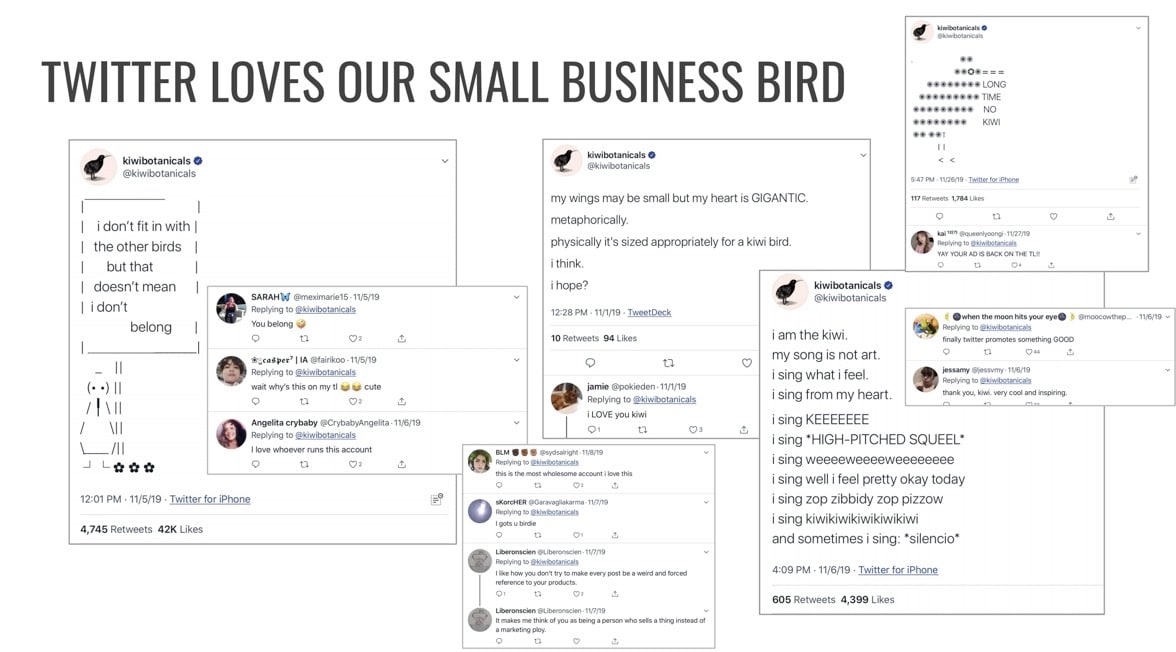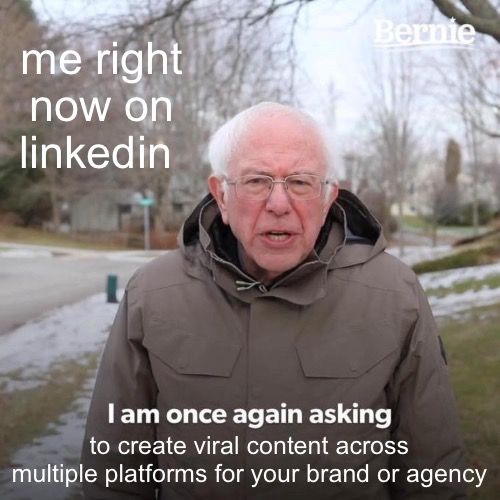Jenn Welch is a standup comedian, improviser, and branded content creator with a proven track record of creating viral content. Since Jenn’s also a comedy instructor, Jenn knows the secrets of Twitter humor and can (and does) explain them clearly. In this interview, Moving Traffic Media asks Jenn about how to successfully use humor, how to create an environment where humor can flourish, and what to do when your brand’s attempts at humor flounder.

I found your resumeme very smart, charming, and funny! How did you come up with the idea?
Thank you! I love “starter pack” memes (the meme format it’s based on), so I had already included a “Jenn Welch Starter Pack” slide at the top of my portfolio. It just had silly stuff like “closet filled with black and grey clothes” with an image of Steve Jobs or “hobbies she’s too young for” with a little image of an old lady doing a jigsaw puzzle. I just wanted to use it as a fun way to show a little bit more about who I am as a person.
Like a lot of people I ended up out of work because of Covid-19 back in March, and after things calmed down a bit in NYC, I started applying for jobs. This might be part laziness, but I get really annoyed when job listings for creatives request a resume – a resume does not show the quality of creative work, and it feels like HR just didn’t adjust their asks for the role they’re trying to fill. Also I hate writing resumes. So I want to just send my portfolio instead, you know, to show them up top how great I am at following rules. But even when jobs request a portfolio, the file size limit on their job site doesn’t allow you to upload a portfolio. So you edit and you prune and the next thing you know you’re just sending them a 5-page pdf that doesn’t show everything you’re capable of.
So, in the midst of all this frustration, trying to edit down my portfolio and whatnot, I realized I could just use the “starter pack” format to show all of the experience / skills / etc. that I would put on a resume. And it’s like, how best to show that you’re a skilled meme-maker than by making your resume a meme? And then I realized that a resume that’s a meme is a resumeme and my brain broke and now here we are!

You’ve successfully used humor to do everything from building a brand voice to writing viral branded Tweets. Is humor something that every brand can make use of or are there types of brands that should steer clear of it?
I think it’s important to know the audience you’re trying to reach, to respect any brand identity that already exists, and to have a reason why you’re trying to add some humor to your messaging. I can’t declare that any brands should or shouldn’t do anything, but I do think that if you’re going to go that route, it’s important to have somebody on your team who understands comedy outside of advertising.
As a stand up and an improviser, I’ve experienced the feeling of a joke not landing, live, in person, in the moment. On stage, my humor tends to be dark, and I’ve learned that if I have an emotional connection to my material – a reason why I’m talking about this dark content – the audience can connect and they’re on my side. So, I mean, if I’m creating social content for a crematorium, do I want to use humor in my content? Probably not. If I’m creating social content for the crematorium across the street from Four Seasons Total Landscaping am I using humor in my content? I’d try it, as long as it’s timely and respectful, because we can all connect on the absurdity of its role in current events. Do crematoriums do social?
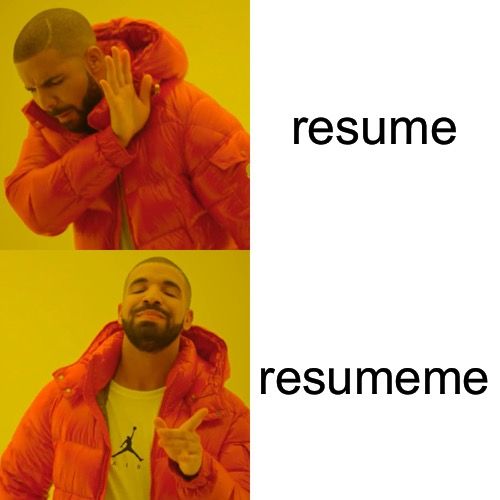
What are some brands that you think make use of humor successfully and what do you like about them?
I feel like we normally think Twitter when we think of brands using humor, but Recess’ Instagram account is killing me. The images are beautiful and absurd and the type of content I’m totally jealous of. I think whatever team designed Gritty, the Philadelphia Flyers mascot, hit on a design / attitude / “voice” that’s so ridiculous you can’t not love it. And, finally, I know they got a lot of attention earlier this year for their serious posts, but I think the Steak-umm account is genius. I think they’re a perfect example of how to do it right – stop trying to sell sell sell in every single tweet, and just post like a regular person. Let your brand live in our reality. Have fun when it’s time to have fun, know meme culture, know Twitter etiquette, but be sincere when it’s time to be sincere.
In your portfolio, you extensively detail how you created the campaign for Kiwi Botanicals from the ground up. When you approach such a project, do you have any sort of personal guide posts that you follow or do you start from scratch every time? What’s useful information for you to have before starting such a project?
Okay, first I want to say that there were a ton of super talented people involved in creating the Kiwi Botanicals brand, but one of the things that those talented people did, which I’m so incredibly grateful for because it’s rare to get a chance to work like this, is they trusted me to have a very big role in establishing the brand’s voice on Twitter and TikTok.
We decided that we’d be tweeting as the bird, and from there I used my experience in screenwriting to develop the character as I would if I were writing a script. What is this bird’s point of view? What has its life been like up until this point? What are its values (especially aligned with the brand values)? How would the bird talk about friendship? Pizza? Syndicated game shows? Whatever. This is the first time I got to approach a project in this way, so, yeah, I basically just approached it as if the Twitter feed were a script I was about to tackle and developed the character the way I would for that.
In terms of information that was useful, knowing that we were a brand that wanted to make high-end natural skincare products more accessible was a big help. This bird just wants everybody to feel good about their skin, no matter who they are. And with that kind of self-acceptance and focus on accessibility, one of the biggest decisions I got to make was that this little, flightless goofball bird was absolutely okay with not flying. In fact, it loved that it got to waddle through the world! And that was such a strong POV to have in my back pocket, while also aligning with my own personal values around advertising.
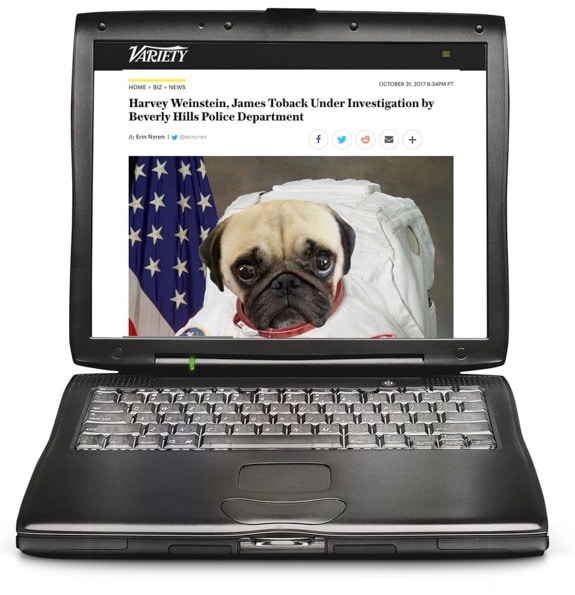
When #MeToo started, seeing the image of a sexual predator was triggering to many. So, Jenn created a Google Chrome extension that replaced photos of sexual predators with funny photos of her pug in outer space. The result was covered by Yahoo!, The Daily Dot, Bustle, Hello Giggles, and more!
What’s an opportunity to use humor that brands often take for granted?
I’ve also worked on social content for a few bigger, more established brands which required client approval for all content, and one of the biggest missed opportunities I’ve seen is when a brand has a perfect connection to something that’s trending or in the zeitgeist, and the content gets stuck in the approval process and never goes out, or goes out awkwardly late.
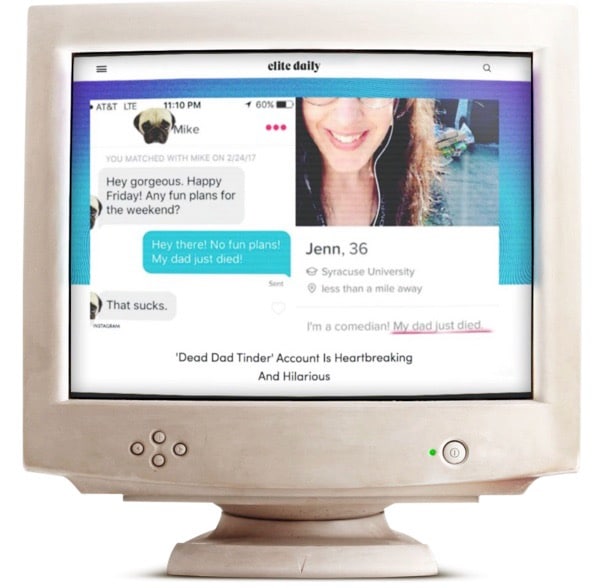
When Jenn’s father died, she added, “my dad just died,” to her Tinder bio, told all her Tinder matches her dad just died, and posted convo screenshots on Instagram and Tumblr. The account went viral, and got international press from Washington Post, Cosmopolitan, Elite Daily, Refinery29, and more.
Along similar lines, what’s a common mistake that brands make when it comes to using humor?
Being funny just for the sake of being funny, or not having a plan for how and why your brand is going to use humor in your content. There has to be a reason, or an emotional connection to it, and your brand should have a specific voice when it comes to *how* it’s funny. Like, just looking at the three examples I posted above – Recess, Gritty, and Steak-umm – the humor is all so specific to their brand, and they don’t really stray from that comedic voice they’ve developed.
If a brand used humor but experienced negative backlash, how would you advise they deal with it?
I mean, all brand accounts get negative backlash. But in my experience, if it’s just grumpy replies on Twitter, ignore them and interact with the folks who love what you do. Within a month of tweeting for Kiwi we literally had followers who would stick up for the bird when anybody posted something negative in the comments – I’m really proud of that. If it’s a bigger “making headlines” kind of backlash? In my opinion that means you overlooked something important, and typically, in my experience, it means you got so caught up in an idea that you didn’t take a moment to think about how the content could be insensitive or hurtful. Empathy is such a huge part of doing funny well. So, acknowledging, reflecting, apologizing, all of that.
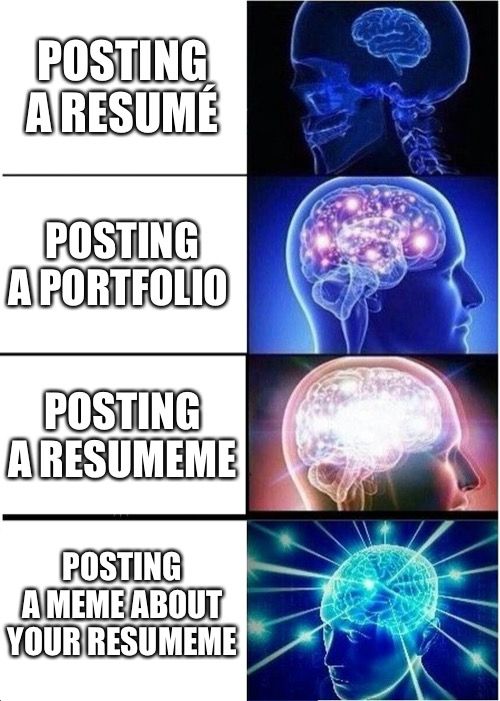
How should brands that use humor behave when a particular issue has gripped the national discourse? Coronavirus and the protests following the murder of George Floyd come to mind.
I think Steak-umm (please check that I’m using the correct number of ‘m’s) is the perfect example of how to handle this. Be sincere. Be humane. And if you’re going to say something, make sure it has substance. If you can’t do any of those things, then at least be respectful and back away from social media for a few days.
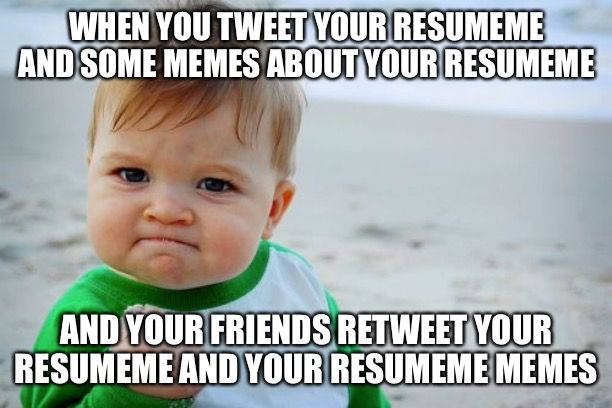
You have extensive experience performing improv, standup, and writing screenplays. Does someone need to have as much experience as you do to incorporate humor into branded content?
When I started working on branded content, I felt like I was near the end of an M. Night Shyamalan movie where every weird thing that I’d done before in my life suddenly had a purpose. I used that experience daily, no exaggeration. I covered the screenwriting above, but even just being a very online person because of comedy – I was so surprised by the edge that gave me. I know how to whip together a TikTok video in an hour on zero budget. I know how to create memes. I know joke formats. I know how to connect with an audience. I’ve been on the other end of the VO recording session, so I know how to communicate with talent to get the punchline to land. I’m not saying that everybody needs to spend years working for pennies and drink tickets in order to do this well. But it’s certainly helped me.
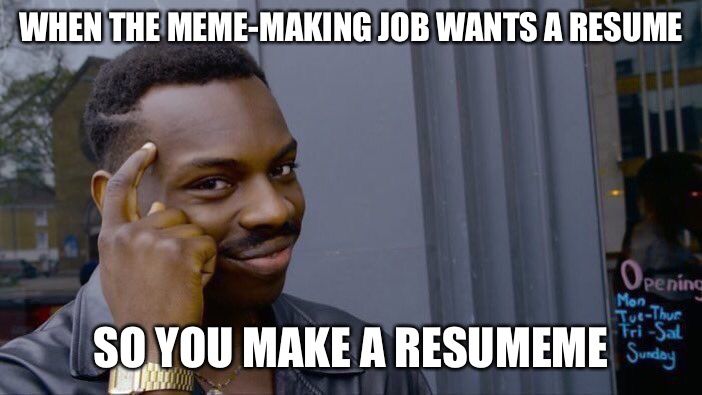
In addition to performing and writing comedy, you have experience teaching improv in both corporate and non-corporate settings. If there’s one lesson you could pass on from improv, what would it be?
Can I give two things?
- There is nothing funnier than an honest emotional reaction.
- Create an environment where your creatives are allowed and encouraged and given space to fail.
Okay, wait a third thing:
- The best ideas are discovered in the space between two or more brains.
Visit Jenn Welch online at follow her on Twitter.



